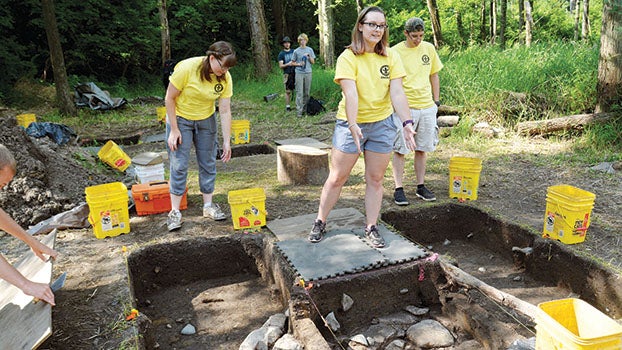Free open house at Fort St. Joseph dig site to show off new discoveries
Published 9:18 am Friday, August 3, 2018
NILES — After weeks of carefully sifting through soil and documenting their finds, college students, archaeologists and community members are ready to show off the history they have uncovered at the Fort St. Joseph archaeological dig site.
The Fort St. Joseph Archaeology Open House will take place from 10 a.m. to 4 p.m. Saturday and Sunday at the fort, which is located at the corner of Fort and Bond streets. This year’s theme is “Technology Then and Now” and seeks to show how the technology of New France shaped daily lives at the fort. In addition to having the opportunity to examine the dig site, people can explore a Living History Village and take a ride in a 36-foot voyageur canoe on the St. Joseph River, as well as listen to period music. The open house is free and open to the public to attend.
On Thursday, the media got a sneak peek of the site and listened to officials reflect on the numerous artifacts this year’s dig had uncovered, including copper rings, the bowl of a clay pipe, silver earbobs, and lead seals embossed with different pictures, to name only a few. This year, visitors will be able to see more of the fort’s historic structures, including the outlines of an 18th Century house.
The artifacts are uncovered each summer through an Archaeological Field School managed by Western Michigan University. Students from the college help to excavate at the site. The community can also get involved through summer camps, where students and experts serve as mentors.
This year marks the 20th anniversary of exploration at the fort – one of the longest running programs in the country that is not state sponsored. In that time, students, archaeologists and community members have discovered more than half a million 18th Century artifacts.
Standing before a crowd of about 30 people gathered at the site Thursday, Michael Nassaney, the principal investigator for the project, commended the partnership between the city of Niles and Western Michigan University.
“Without that partnership, we wouldn’t be doing this work and wouldn’t be where we are today,” Nassaney said. “It takes a village and a university and I think we do it with a lot of panache.”
Nassaney’s voice thickened with emotion at times, as he ticked off a few notable accomplishments in the project’s history, including connecting more than 20,000 visitors with Niles’ history through the archaeological site, teaching about 200 students hands on skills in archaeology – helping many of them to go on to distinguished careers, including a student who went on to become a FEMA archaeologists.
One intriguing challenge to excavating remains is that archaeologists are drawing the map of the Fort St. Joseph as they go, because no prior drawings have ever existed.
“Our excavations over the last 20 years have now identified six structures,” Nassaney said. “Not only do we know where these are, we know how they were constructed. We know their contents and now we can begin to say something about the people who lived there.”
Mayor Nick Shelton also addressed the crowd, reveling in the number of surprising artifacts that had been uncovered and thanking those involved in the excavation for helping to connect the community with their local history. He said he looked forward to many more years of their partnership.
“There’s definitely something for everyone at the Fort St. Joseph Archaeology Open House,” Shelton said. “This weekend, [my family] looks forward to ditching our devices to learn about the tools right here in the 18th Century.”
Several other speakers also addressed the crowd, including Jody Brylinsky, associate provost of institutional effectiveness at Western Michigan University; James Cousins, associate dean for the College of Arts and Sciences at Western Michigan University; field school student Sami Brown and Dean Anderson, state archaeologist.
With the chance to see the many discoveries uncovered this summer, experts and field students alike said visiting the open house will offer a unique opportunity.
“The bottom line is we are building community,” Nassaney said. “We are bringing people together into a large conversation in which we can use the past to reflect on who we are as a people. [It] helps us to reflect on the similarities among all of us and the differences as well. This is really what the project is about.”









